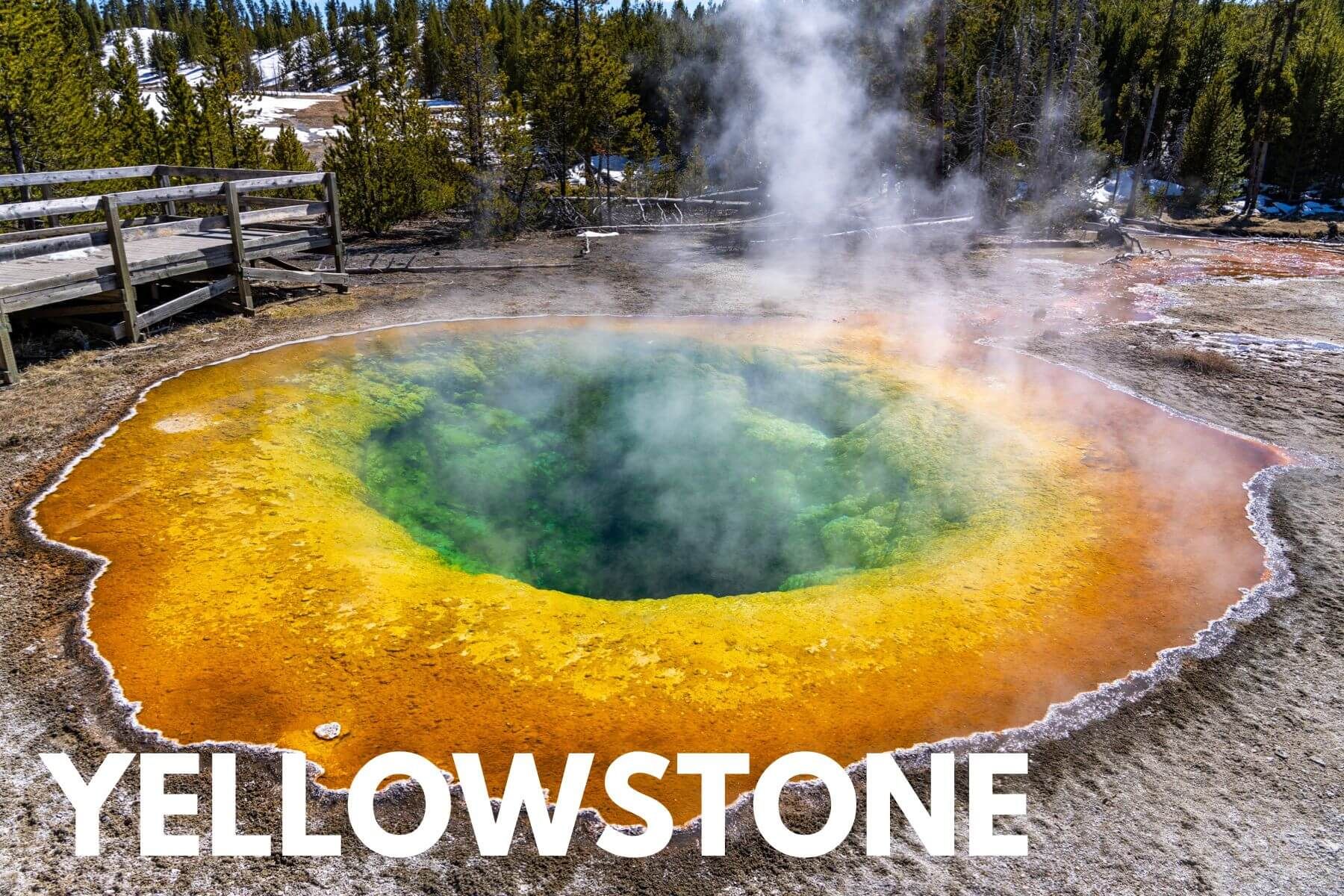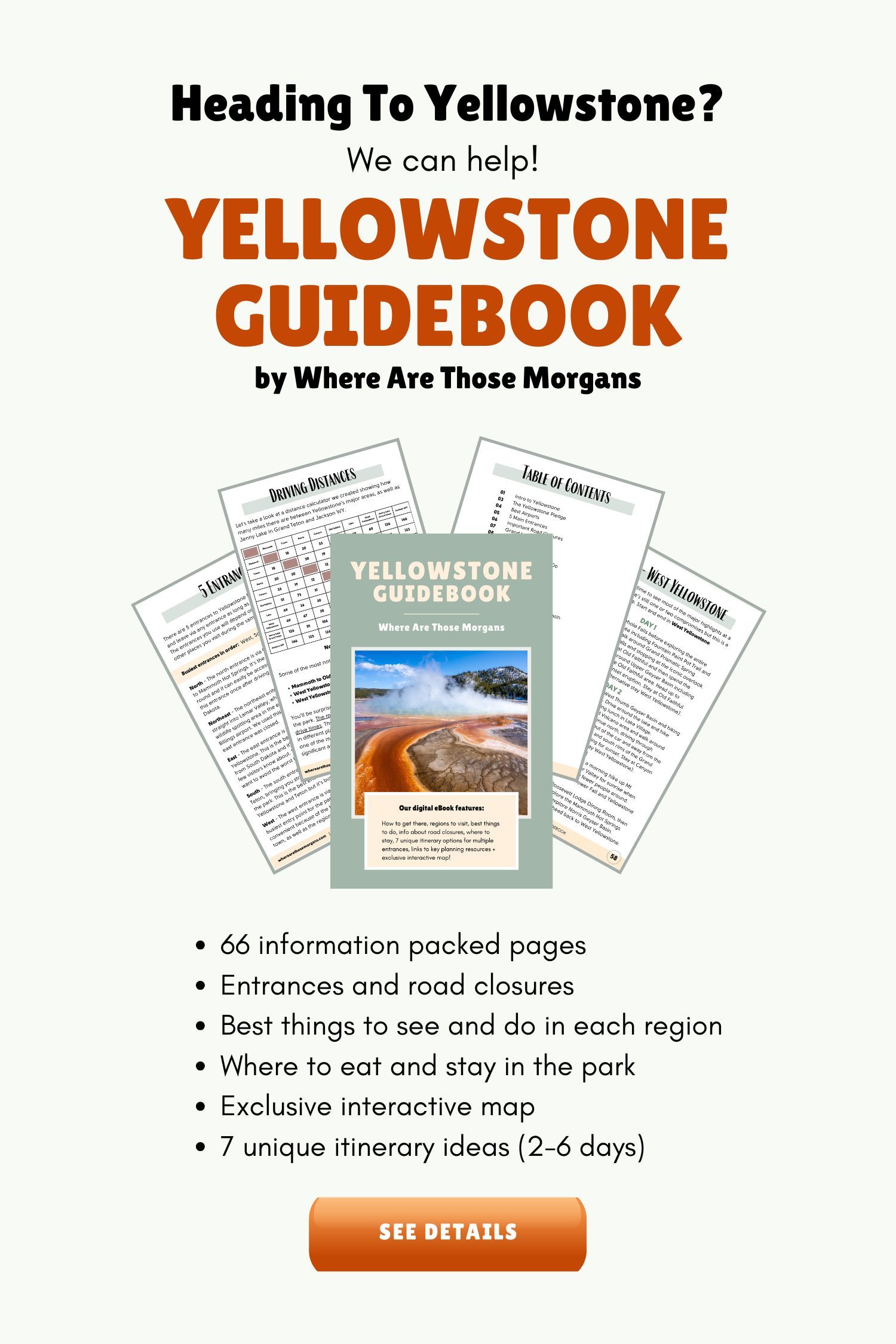Yellowstone is one of the most famous, striking and unique national parks in the US. In this isolated volcanic landscape you can listen to geysers erupting and mud pots bubbling, see hot springs so vibrant it’ll blow your mind, and spot rare animals like wolves and bears roaming in the wild.
We’ve spent a total of 7 days in Yellowstone between trips in October 2019 and April 2021, so we know how exciting but difficult it can be to plan a visit to the park. Especially when it’s your first time.
In this comprehensive Yellowstone National Park travel guide we help you plan your first trip to northwest Wyoming’s world famous destination, based on our own experiences. We’ve written lots of guides about Yellowstone, so click the orange links in this guide if you want to learn more.
If you’re a serious planner like us, be sure to check out our popular Yellowstone National Park Guidebook which goes into far greater detail with bonus itineraries, maps and more. Or, if you’d like personalized help planning your trip, book a 1-on-1 call with us.
Note: Our content is reader supported and contains affiliate links. If you make a purchase through one of these links, we may earn a small commission at no extra cost to you and it helps us keep this site running.
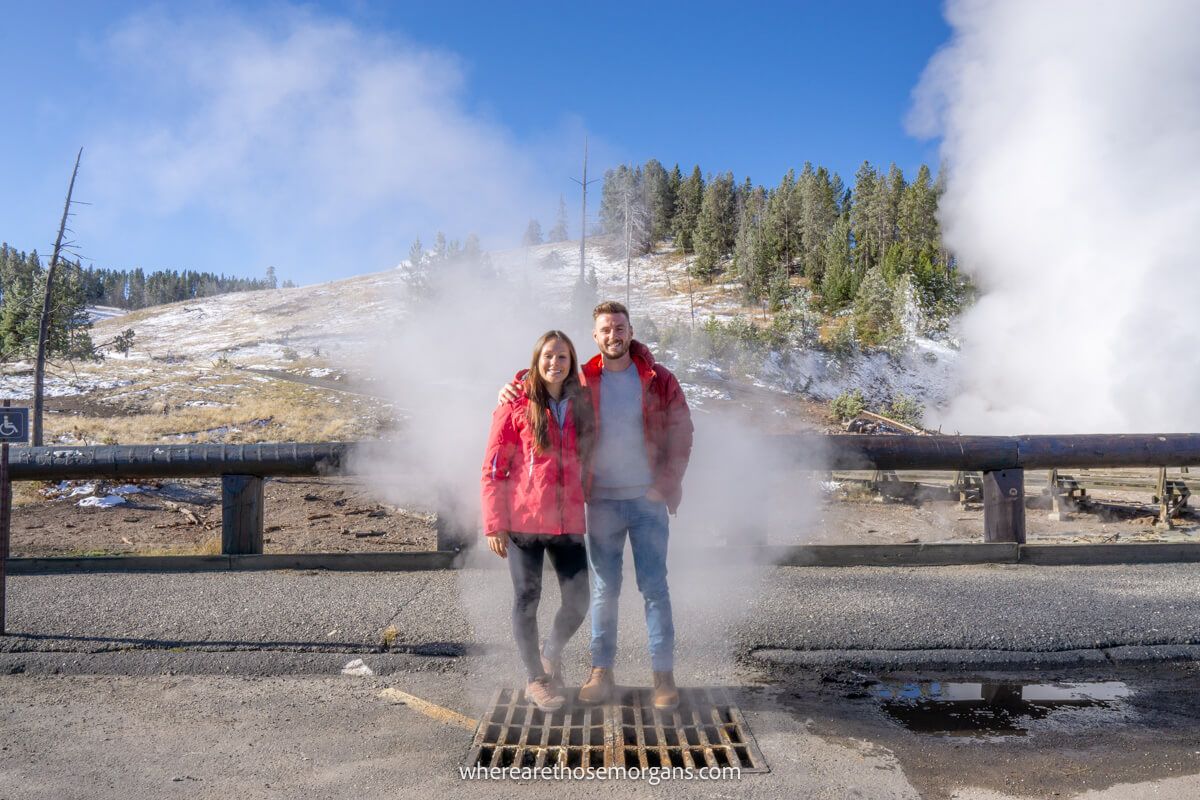
Park Information
Here’s a general overview of Yellowstone National Park to get you started:
- States: Wyoming, Montana and Idaho
- Established: March 1st, 1872
- Size: 2.2 million acres
- Caldera: 45 miles x 30 miles
- Last eruption: 640,000 years ago
- Geothermal features: 10,000
- Geysers: 300
- Annual visitors: ~ 4 million
- Summer season: April-October
- Peak months: July-August
- Entrance fee: $35/vehicle
- Major trail: Mount Washburn
- Lodging: Lots inside and nearby
You’ll pay $35 for a 7-day permit to enter Yellowstone. This fee is for your vehicle and all passengers. So you’ll pay the same for 2 people as you would for a full family of 5.
The only way to get free entry to Yellowstone is if you have an in-date America The Beautiful Pass, also known as the Interagency Pass.
What You Can’t Miss
There are so many amazing things to see and places to visit in Yellowstone National Park. For us, it’s a landscape that’s more about sightseeing and photography than it is about hiking, so our advice is to focus your efforts mostly on the geyser basins and popular wildlife spotting areas.
Our top recommendation is to get an early start and stay out late so you have a better chance of seeing animals and enjoying the most popular areas without the crowds.
Here are the places we would prioritize above all else:
- Old Faithful and Upper Geyser Basin
- Grand Prismatic Spring and Midway Geyser Basin
- Grand Canyon of the Yellowstone
- Lamar Valley and Hayden Valley
- Norris Geyser Basin
- Mammoth Hot Springs
- West Thumb Geyser Basin
- Mount Washburn (hike)
And here are some of our favorite experiences in Yellowstone so far:
- Watching Old Faithful erupt from both the bleachers and from behind it in Upper Geyser Basin
- Seeing Grand Prismatic Spring for the first time
- Spotting wolves and bald eagles (we’re yet to see a bear in Yellowstone)
- Photographing Grand Canyon of the Yellowstone at sunrise and sunset
- Being stopped in the road by 20+ bison
- Seeing dozens of unique geysers in Norris and West Thumb
Yellowstone really is full of astonishing geothermal features, which is why this place is so popular. But if you’re a keen hiker and you’re determined to hit the trails, you should consider Mt Washburn, Fairy Falls, Mystic Falls and for a real challenge Avalanche Peak.
Yellowstone Itinerary
Okay, Yellowstone is enormous. It has 6 unofficial regions and 5 entrances, plus all its top attractions are spread right across the park. So planning the perfect first time itinerary becomes very challenging, especially when each visitor will use different entrances, have different goals and be restricted by different timeframes. With that said, we’ve done both a 3-day trip and a 4-day trip, and we think 4 days in Yellowstone is the perfect amount of time for a first visit.
Here’s a summarized version of the best way to spend 4 days in the park (beginning at West Entrance and leaving through South Entrance):
- Day 1: Start with Gibbon Falls, hike to Monument Geyser Basin, walk to Artists Paintpots, explore Norris Geyser Basin and finish at Mammoth Hot Springs. Stay in Mammoth or Gardiner.
- Day 2: Start early with Lamar Valley, hike to Tower Fall and Yellowstone River overlooks, hike Mount Washburn and finish by driving the North Rim of Grand Canyon of the Yellowstone. Stay in Canyon or West Yellowstone.
- Day 3: Start with South Rim of Grand Canyon of the Yellowstone, drive through Hayden Valley, visit Mud Volcano, stop at Yellowstone Lake and finish with a walk around West Thumb Geyser Basin. Stay in Old Faithful or West Yellowstone.
- Day 4: Start with Fountain Paint Pot Trail, walk around Grand Prismatic Spring, hike Fairy Falls Trail, explore Upper Geyser Basin and watch Old Faithful erupt. Leave through the south and spend 2 days in Grand Teton.
With less time we would prioritize Upper, Midway and Lower geyser basins, along with Norris, Mammoth and West Thumb. They’re all located on the west side of Yellowstone so it’s easier logistically.
With more time we’d add a few more hikes into our itinerary. Four days is a good amount of time to see each region of the park comfortably, but with 5 days or more you might run out of things to do unless you use up a portion of that time hiking. In truth, with more than 4 days we’d likely just allocate that extra time to enjoying Grand Teton.
Need help planning your trip to Yellowstone?
Skip the research and master Yellowstone instantly with our expert guidebook. No fluff, just exactly what to see in each region, custom itineraries, insider tips, exclusive map and more.
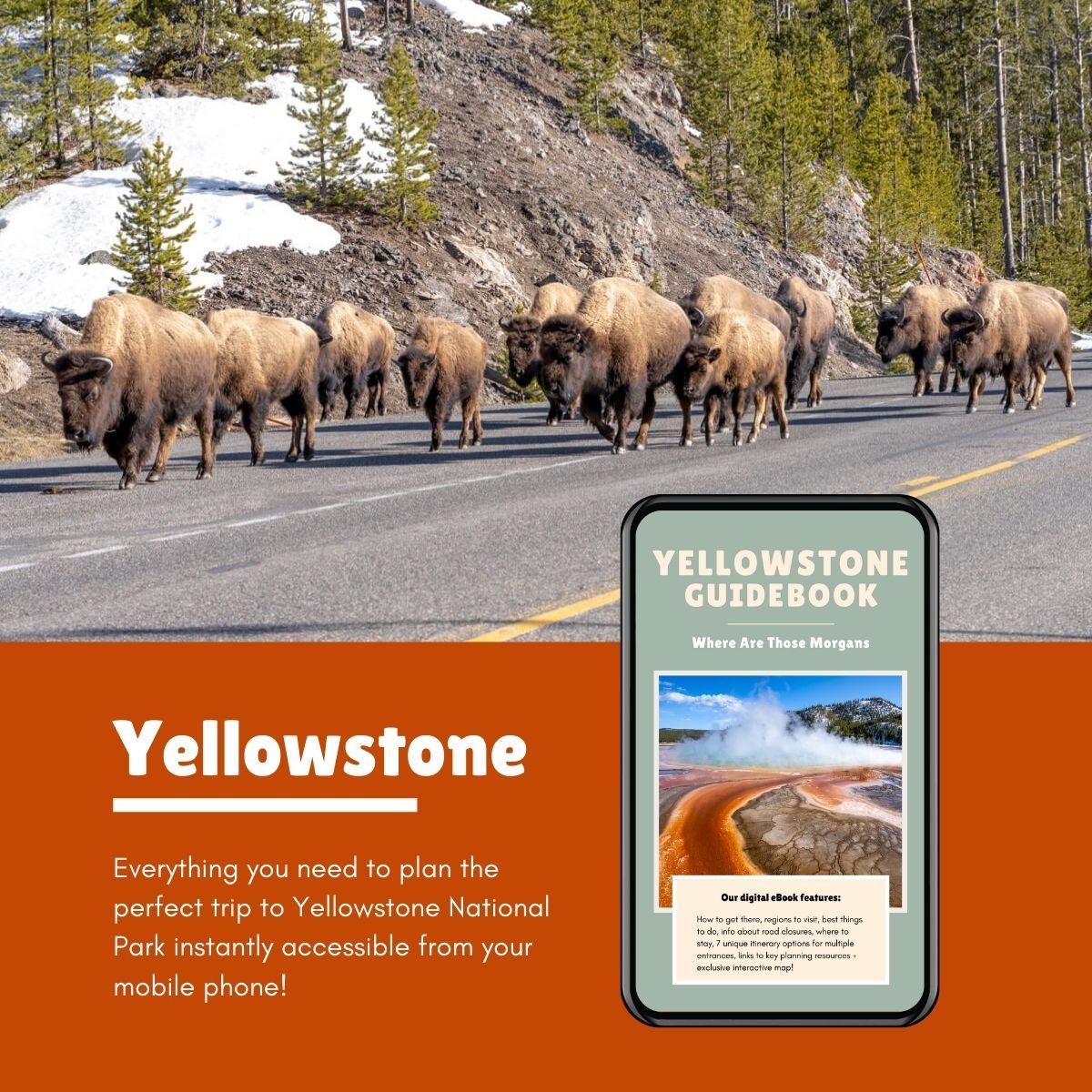
Where To Stay
We’ve always felt that figuring out where to stay at Yellowstone is the hardest part about planning a trip to the park, whether it’s a first or fifth visit. So far we’ve stayed at cheap, mid range and luxury hotels in each of Cody, Gardiner, West Yellowstone, Mammoth, Canyon and Jackson. They’re all great spots in and around the park, but we really like Cody and Jackson.
We prefer to move hotels each night when we visit Yellowstone so we have maximum efficiency and less driving. But you could stay in one hotel for your entire trip if you don’t mind driving the extra miles each day. There’s no right or wrong way to do it, and both ways have pros and cons.
Here are the major accommodation options inside the park:
- Mammoth Hot Springs
- Roosevelt Lodge
- Canyon Lodge
- Lake Yellowstone Hotel
- Lake Lodge Cabins
- Old Faithful Inn
- Old Faithful Lodge Cabins
- Old Faithful Snow Lodge
- Grant Village
Here are the top rated hotels in West Yellowstone:
- Budget – Al’s Westward Ho Motel
- Mid range – Crosswinds Inn
- Mid range – Kelly Inn
- Luxury – Explorer Cabins
- Luxury – Yellowstone Park Hotel
And here are the top rated hotels in Gardiner:
- Mid range – Yellowstone Gateway Inn
- Mid range – Yellowstone Riverside Cottages
- Mid range – Yellowstone Basin Inn
If you want to stay at hotels or lodges inside the park, you must book as far in advance as you possibly can because they fill up long before the next summer season. So let’s say it’s November and you decide to go to Yellowstone next June, book your accommodation immediately in November.
The only places outside of the park you should realistically consider staying for the duration of your trip to Yellowstone are West Yellowstone and Gardiner because you can day trip into the park easily enough from both. The others are not really day trip friendly.
We recommend staying in Cody for a night before entering the park if you’ll be driving across from South Dakota. This way you get a good hotel at reasonable prices and a great restaurant selection, before entering the park first thing the next morning. The same applies to Gardiner if you’ll be coming down from Glacier or West Yellowstone if you’ll be arriving from the west. Cooke City is much smaller with just a few hotels and eateries, whereas Jackson works best when visiting Grand Teton.
Airports
There are tons of airports near Yellowstone that you can consider flying into and out from when you visit the park. The best airport to use will depend on whether you’re traveling domestically within the US or internationally from abroad, which entrances you plan to use on the way in and out, and where else you plan to visit either before or after Yellowstone.
Here are the 4 airports we’d consider using:
- West Yellowstone – Closest regional airport to Yellowstone
- Jackson Hole – Closest to Grand Teton
- Bozeman – Closest major domestic airport to Yellowstone
- Salt Lake City – Closest major international airport to Yellowstone
Denver is the other major international airport you can try if you’ll be flying in from Europe, Asia or South America. But it’s an 8 hour drive to Yellowstone, so you might want to consider breaking up the drive, visiting Rocky Mountain first or maybe even catching a connecting flight into West Yellowstone or Bozeman.
Remember, you can use different airports for arrival and departure. For instance you could arrive into Salt Lake City and leave from Bozeman. Just make sure the hire car company you use allows pick up and drop off locations to be different. We know that Rental Cars offers this service. The hire car price will likely be more expensive, but it gives you some flexibility to play around with flights if you can’t find good value in a return ticket.
Yellowstone National Park Entrances
Yellowstone National Park has 5 entrances spanning the compass points, with a plus one in the northeast:
- North – Gardiner, Bozeman
- Northeast – Cooke City, Billings
- East – Cody, South Dakota
- South – Jackson, Grand Teton, Denver
- West – West Yellowstone, Salt Lake City, Idaho
You can enter or leave through any of them as long as they’re open (we’ll talk about road closures later). Again, there’s no right or wrong way to enter or leave the park. You won’t miss out on things going one way or the other. The only exceptions are an increased chance of seeing wildlife if you enter or exit through northeast or east entrance at dawn or dusk. And even then, there’s no guarantee so we don’t recommend planning around those circumstances.
On our first trip we entered from the northeast around midday and didn’t see much in Lamar Valley, then we left through the south at around midday for Grand Teton. For our second trip we entered from the north first thing in the morning after spending a night in Gardiner, before leaving through the west as the sun was setting.
The west entrance is busiest, followed by south, north, east and northeast. In peak seasons, lines to get through the kiosks and barriers into the park can be very long. We strongly advise you get through an entrance to the park early morning if you visit in July or August.
Getting Around The Park
Once you arrive into Yellowstone, you’ll be driving around the Grand Loop Road to access each area of the park. It looks exactly like the number 8, with a loop at the top and a loop at the bottom connected in the middle. The roads are slow, animals like bison often walk along the main roads or walk through the touristy areas like Mammoth, and in peak season the roads will be heavily congested.
Most of the popular basins, hiking trailheads and other attractions have a good amount of parking spaces. But parking lots will fill regularly if you visit in July or August. The other thing to avoid is abandoning your car in the middle of the road if you see other people looking at an animal. It’s not fun being stuck in your car because someone else has blocked the road. There’s only one road for everyone to use going both ways.
The reason we like to move hotels each night is to cut down on the amount of miles we have to drive on the Grand Loop Road. Yellowstone National Park is enormous, it’s the second largest park in the lower 48 after Death Valley. So to get back to somewhere like West Yellowstone each evening can be grueling if you’re out in Lamar Valley or down at West Thumb.
Road Closures
One of the most important things to consider when visiting Yellowstone National Park is what dates of the year each road opens and closes based around the snowy winter season. Each of the major roads running into and around the park has different opening and closing dates, but you’ll only be affected by this if you plan to visit in April, May or October.
With that said, we encourage you to always keep on top of live road conditions in the park in case of any sudden closures, even in the summer months. Yellowstone sits on top of an active volcano and you never know when a geyser basin might erupt, a flood might cause a landslide or animal activity might shift.
Both times we’ve visited Yellowstone, the road between Canyon and Tower has been closed. So we’re yet to hike Mount Washburn, which will be top of our list for our next visit.
Best Time To Visit
We think the months of April, May, June, September and October are the best times of year to visit Yellowstone. During these shoulder months you’ll benefit from fewer crowds, cheaper hotels with more availability and cooler temperatures.
July and August are incredibly busy, and Yellowstone effectively turns into a theme park. Between November and March, you can only get around Yellowstone with snowmobiles, snowshoes or skis.
We’ve been to Yellowstone in April and October. We had to deal with snow, cold weather and road closures so carefully consider if these conditions are a deal breaker for you. But hotels were empty and affordable, there were barely any other people around, the roads were quiet and animals were active.
So it was a trade off, and it was one we were happy to take. Next time we’ll visit in June or September when more roads and trails will be open but it won’t be at peak capacity.
Road Trips To Yellowstone
Are you planning to visit Yellowstone alone? Or will you be combining it with other national parks or tourist hotspots? At a bare minimum, we highly recommend you spend at least one day in Grand Teton before or after Yellowstone. Ideally, you’ll have 2 days for Grand Teton because it’s a stunning park with lots to do.
One of our favorite ways to see Yellowstone and Grand Teton is to combine them with South Dakota’s stunning Black Hills region. We’ve driven this fantastic route twice now and we highly recommend it. Our Mount Rushmore to Yellowstone road trip post covers a 10 day itinerary including both areas. Or if you’re a serious planner, you should take a look at our Mt Rushmore to Yellowstone Guidebook which includes daily route maps and so much more.
Alternatively, if you’ll be flying into SLC you can read our Salt Lake City to Yellowstone road trip guide to see exactly how to plan a 7 day trip through Grand Teton and Yellowstone. You can even continue on to Glacier National Park afterwards if you’re taking a longer trip.
Finally, if you want to visit Utah’s Mighty 5 parks along with Yellowstone and Grand Teton in the same trip, you should use Las Vegas and either Salt Lake City or Bozeman as your airports on the way in and out. Read our guide on the best Utah road trips to see how you can make the most of your time in the Beehive State.
Tours
Yellowstone isn’t as well known for guided tours as places like NYC or Paris. But you might be surprised at how many highly rated tour options are available, just in case you’d rather let someone else do the driving and explaining.
Our Yellowstone National Park Photos
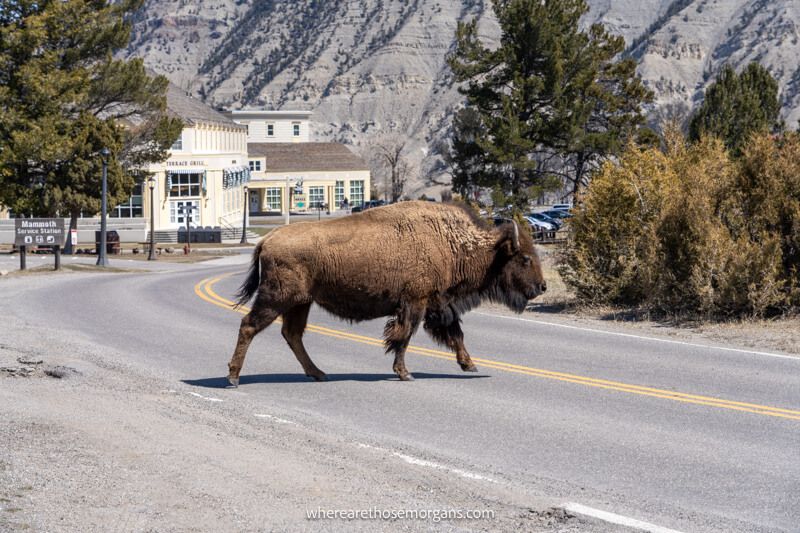
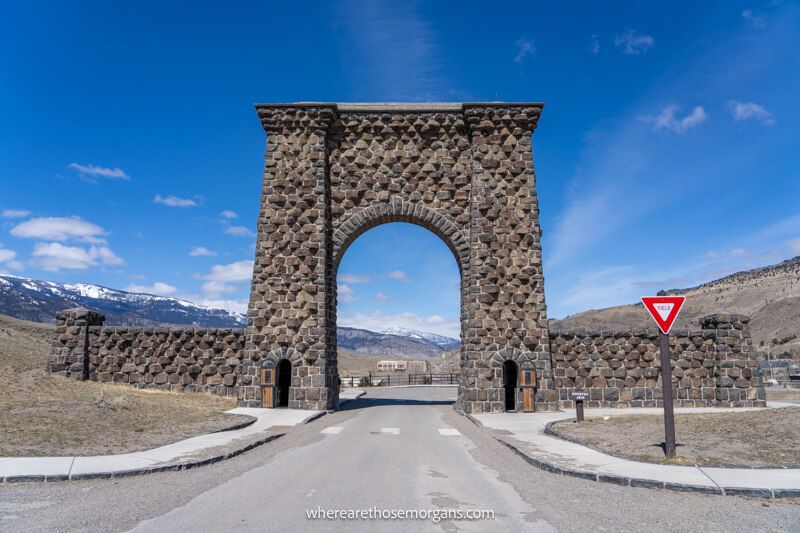
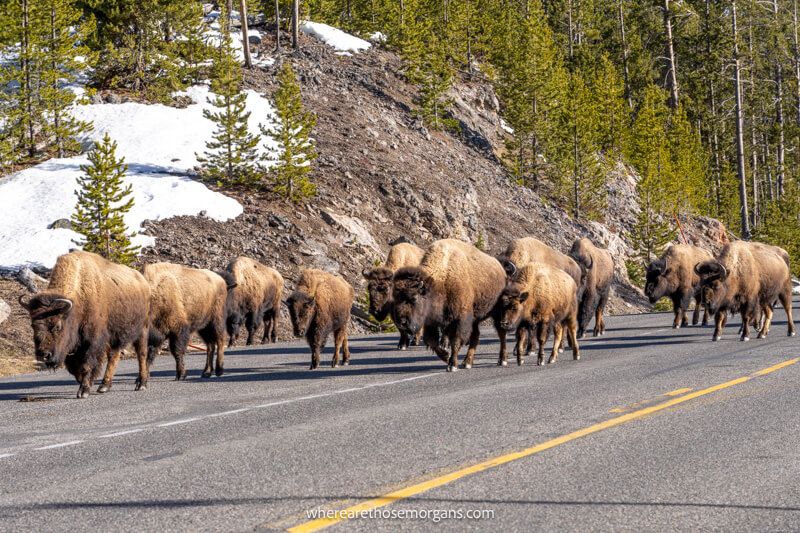
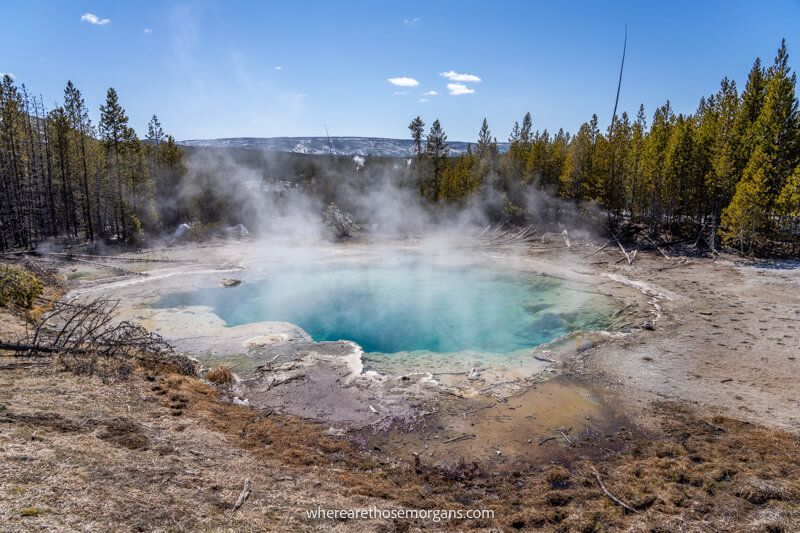
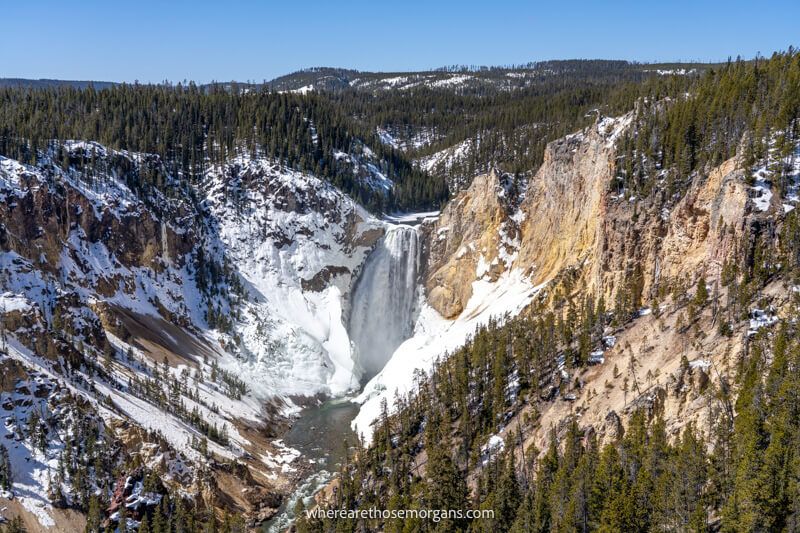
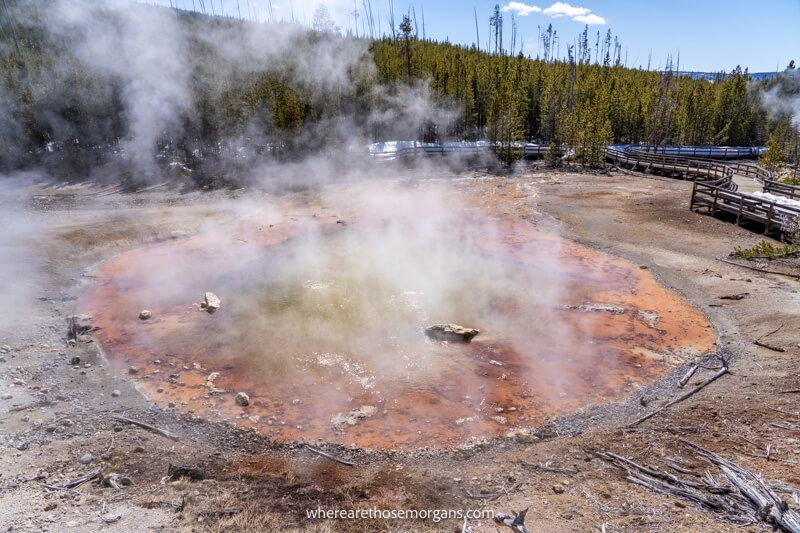
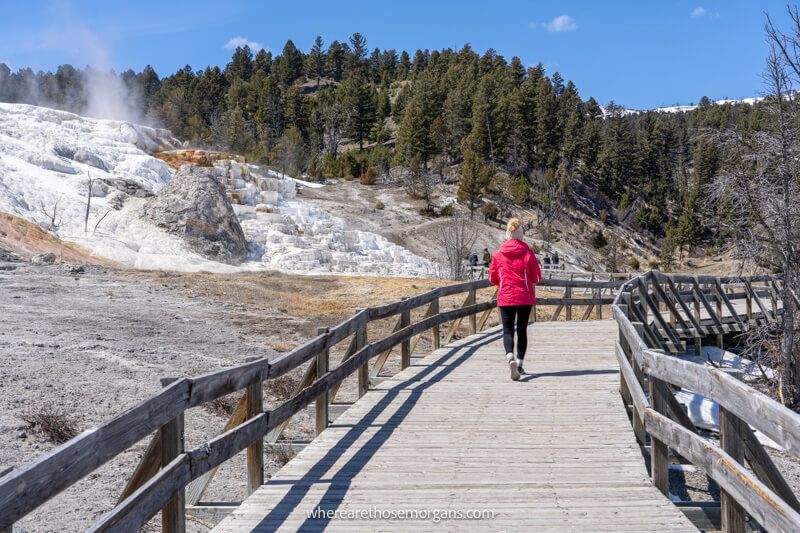
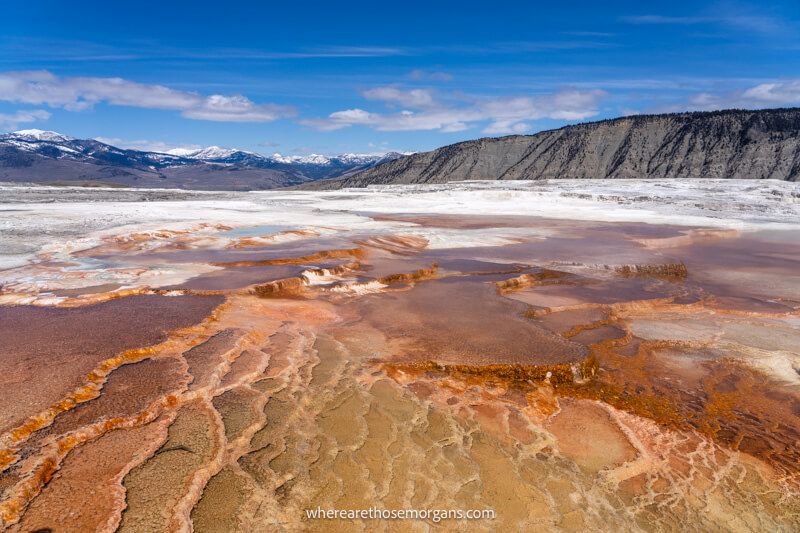
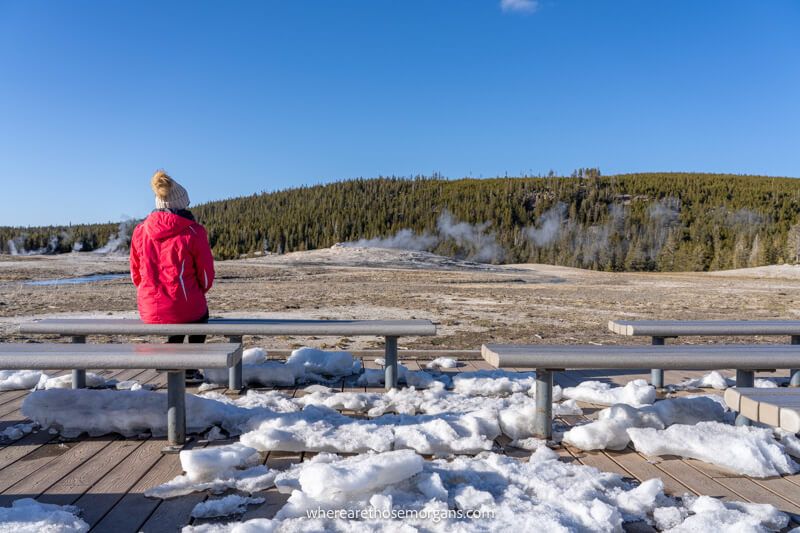
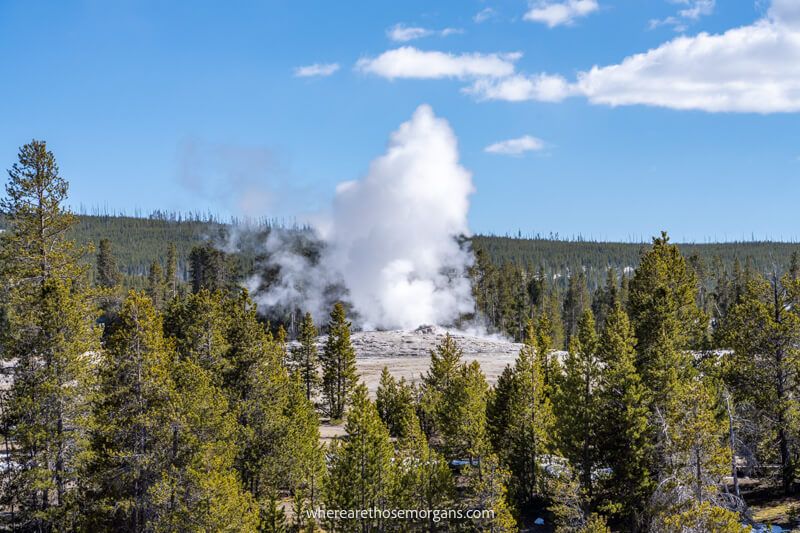
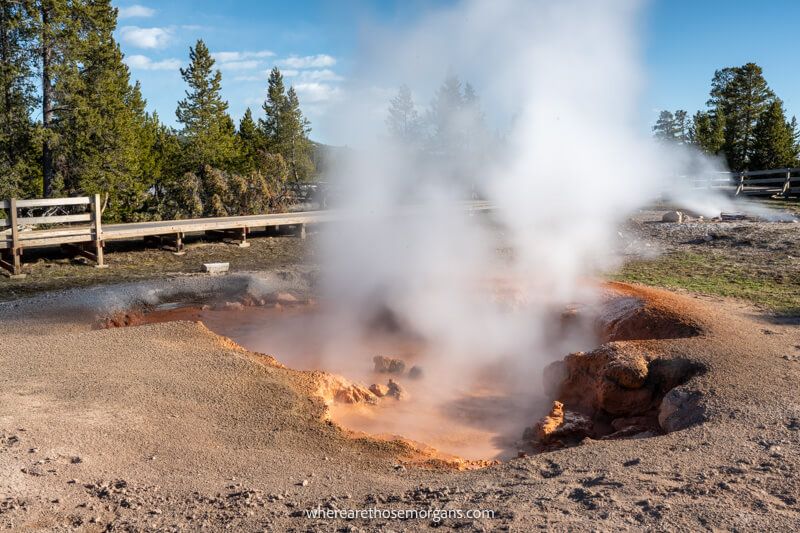
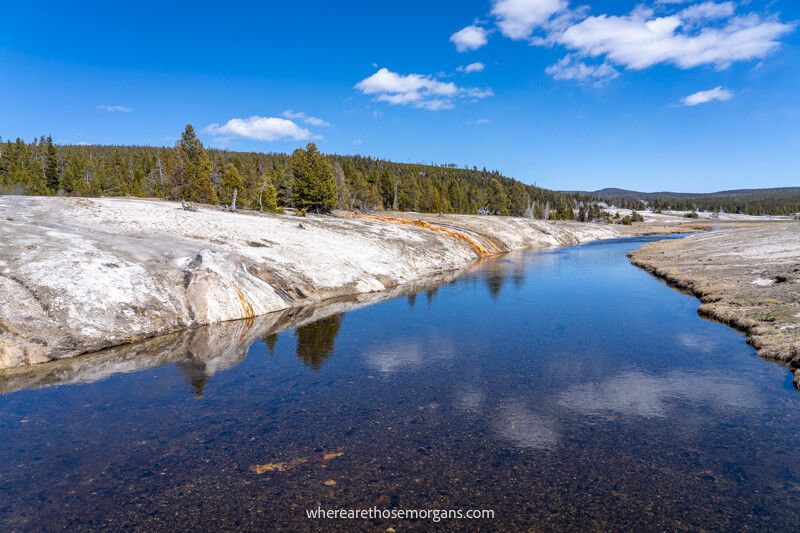
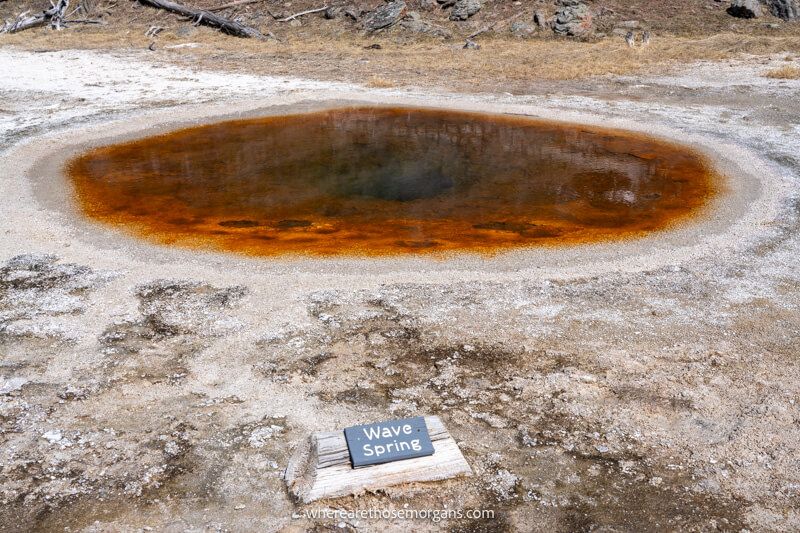
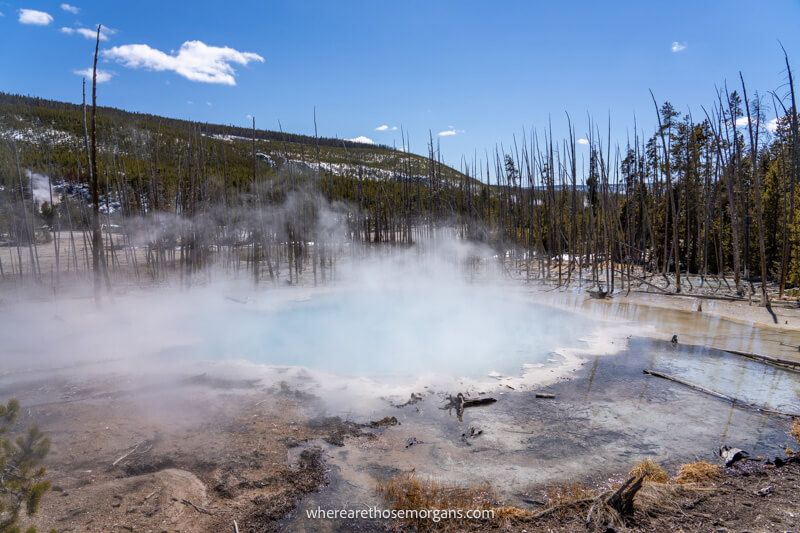
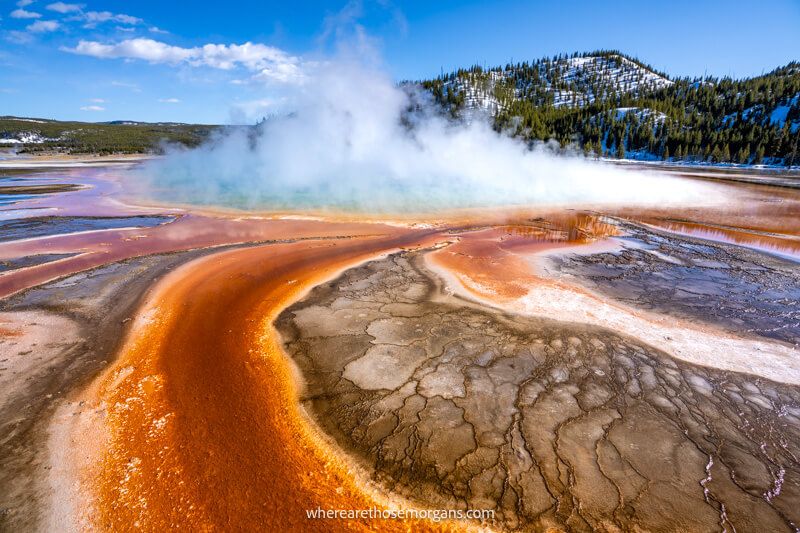
Next Steps
We hope our Yellowstone National Park travel guide helps with planning your trip, but please let us know if you have any questions in the comments box a little further below.
Still figuring out your plans?
- Read our 4 days Yellowstone itinerary.
- Here’s our favorite things to do in Yellowstone.
- These are our top places to stay in Yellowstone.
- Start your hotel search around West Yellowstone.
If you need a bit more help getting things organized, take a look at our expert guidebook (it only costs $9.99 and it will help you figure out every aspect of your trip – plus it has an exclusive map you can use when you arrive into Yellowstone).
Or if you want our personal advice, tips and a custom itinerary, book a 1:1 planning call with us.
Finally, if you’ll be visiting more places in the area, here’s our Wyoming travel planning guide you can use to learn more about the state.
Happy Travels,
Mark and Kristen
Enjoy this guide? Pin it for later!
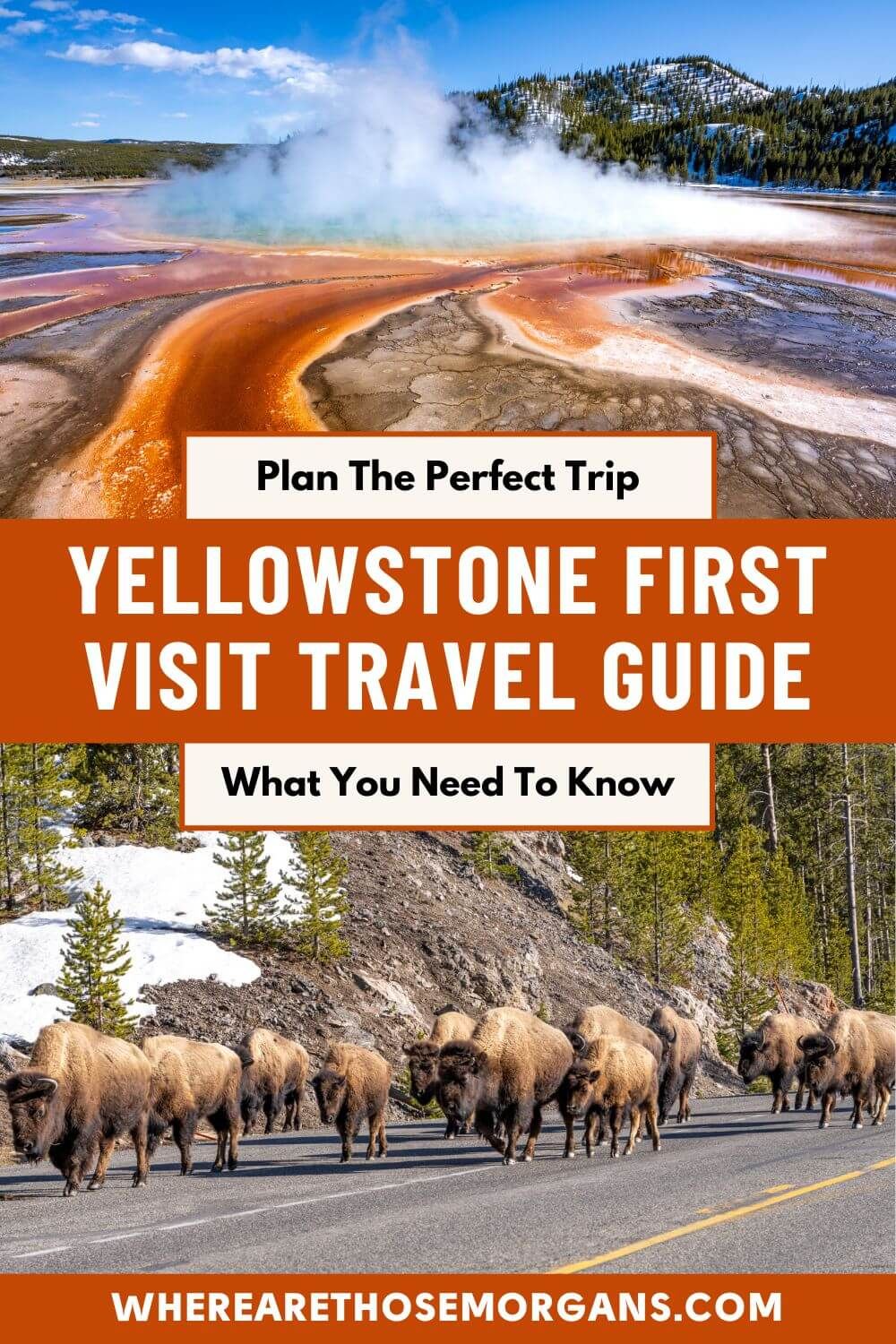
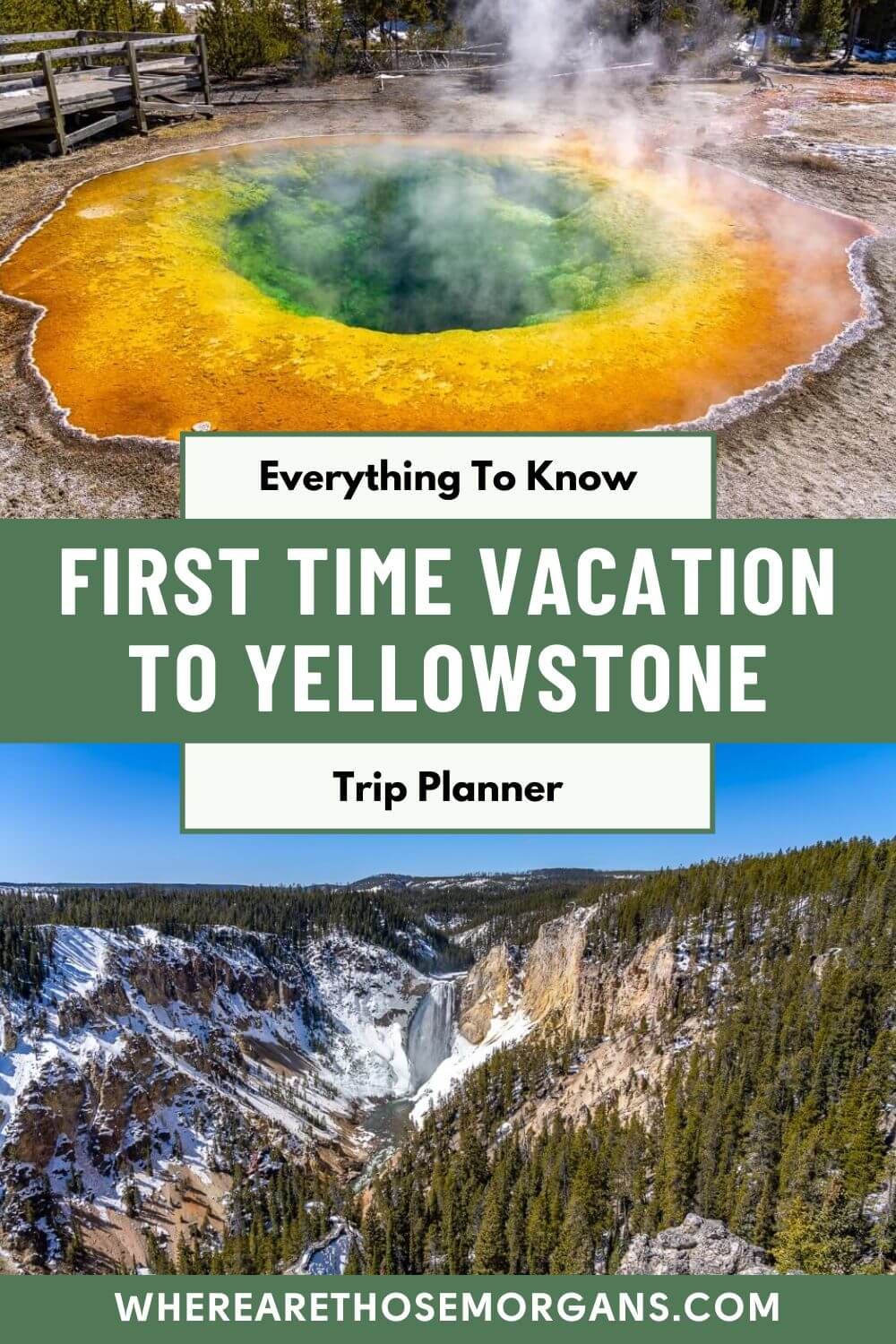
All Rights Reserved © Where Are Those Morgans, LLC. Republishing this article and/or any of its contents (text, photography, maps, graphics, etc.) in whole or in part is strictly prohibited.

